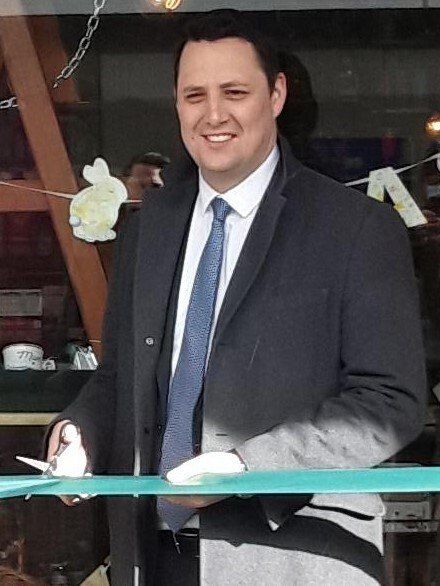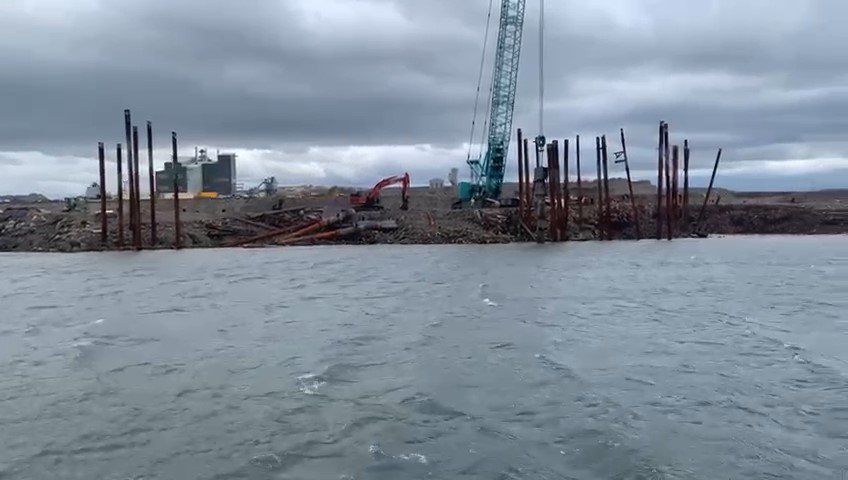The Slime
Behind the Smile:
Houchen and
the Politics
of Dredging
the Tees


Tees Valley Mayor, Ben Houchen South Bank Quay, under construction
Scott Hunter
5 September 2022
Teatime on 1 September and the TVCA puts out a press release stating that dredging for the South Bank Quay project is about to start. It is accompanied by some reassuring words from Tees Valley mayor, Ben Houchen:
“Let me be clear, not a single gram of dredged material will be disposed of in the river or out to sea. Everything is being removed from the river and disposed of safely on land.”
Time for a huge sigh of relief from those who have campaigned against the dumping of toxic sediment in Tees Bay?
Not so fast.
This statement is not quite what it seems. Which is presumably why Teesworks has spent the past couple of days issuing statments that qualify their original claims. And, for the sake of transparency, they’re now advertising the Marine Management Organisation licence application for Phase 1 of the quay – MLA/2020/00506. (If you haven’t checked that out yet, may we forewarn you that it contains dozens of documents, running to thousands of pages. And is not for the faint hearted).
In Thursday’s announcement we were told that “approximately 125,000 cubic metres of dredged material will be removed from the river” before being reassured about the single gram. So, what’s wrong with that?
Take a look at the licence for Phase 1 of the South Bank Quay development, issued in February this year:

The licence allows for 715,000m3 to be dredged from the channel and berth pocket alone. So the 125,000m3 given in the press release amounts to about one fifth of the permitted dredge.
So where is the other 600,000m3 going? And why are the contractors handling the 125,000m3 differently?
Well, there’s a condition on the licence, which states that the material within a given set of coordinates are prohibited from disposal at sea. This area is shown by the four red markers on the map below:

This area is the northernmost end of the proposed scheme:

Source: Royal Haskoning Environmental Impact Assessment for South Bank Quay. The areas of the river to be dredged are marked in red. The area of the bank to be removed is marked in black. The area indicated on the map marks both Phase 1 and Phase 2 of the scheme.
The green markers on the map above, incidentally, show where sediment sampling was carried out. Notice that there are two of these within the rectangle delineated by the red markers. You may wonder why the MMO took the drastic step of disallowing disposal at sea of material within the whole rectangle when sampling was only undertaken at one end of it.
This is because the MMO already had a fair idea of what is down there. The Northern end of the South Bank Quay overlaps with an earlier, now abandoned, project – the QEII Berth development. When sampling was done for this project in 2008, heavy contamination down to very deep layers of sediment was found there.
The double green marker in this prohibited area is where Teesworks had their contractors sink a borehole – borehole 34. The FAQ supplement to their weekend report helpfully informs us that that,
“At only one borehole location of the dozens of locations undertaken during testing, the concentrations of cadmium, chromium, copper, mercury, lead, and zinc exceeded the respective Cefas action level 2 (AL2) thresholds. Results above AL2 means the material is not suitable for disposal at sea. No other toxins were identified or exceeded mandatory thresholds.”
Unhelpfully, they omit to add, that a total of eight dissolved metals were tested for. So excessive concentrations were found for six out of this eight.
The report also omits to mention that the eight that are tested for are specified by Cefas, the partner agency of Defra that has responsibility for sediment monitoring. One of the things that Cefas does not do is to tailor its testing specifications to local circumstances. One of the reasons that this is of particular concern in relation to the Tees is that, when it comes to hydrocarbons, Cefas does not require that samples are tested for Pyridine, the chemical that has been found in high concentrations in crab tissue since the die-off began.
So, at this point, we have no idea how much pyridine is contained in the sediment tested for. More than once in the statements issued over the weekend, Teesworks has asserted that it has gone above and beyond what was required by the MMO in its investigations. It is unfortunate that its spirit of willingness did not extend to testing for this particular toxin.
Another part of Teesworks’ statement serves to obscure rather than clarify the situation with regard to other toxins, where it states that ‘no other toxins were identified or exceeded mandatory thresholds’, the mandatory threshold in question being Cefas Action level 2.
Cefas Action Levels
To explain, Cefas has produced a set of guidelines for toxins in sediment, based around two action levels. Where the concentration of the toxin is below level 1, there is no cause for concern. Between levels 1 and 2, some consideration needs to be given as to how best to dispose of the sediment safely. If the concentration exceeds level 2, then disposal at sea should be prohibited.
Sounds straightforward? The reality is unfortunately a little more convoluted. While Cefas specifies two action levels for dissolved metals, like those named above, it does not do so for hydrocarbons. This is particularly important in the Tees as hydrocarbons are the most widespread contaminants in the sediment here. For hydrocarbons, at the time the testing was done here, Cefas specified only one level.
By specifying only one level, hydrocarbon concentrations could be 1000 times higher than level 1, and still not be flagged up as problematic. Cefas specifies that 22 hydrocarbons should be tested for. Royal Haskoning published a Supplementary Environmental Information Report (6 May 2021), in which they make the following observation about the data on hydrocarbons
“Polyaromatic hydrocarbons (PAHs)
“The results from BH34 show significant PAH concentrations throughout all depths, consistent with the metal concentrations (well in exceedance of Action Level 1). There are also significant concentrations of many PAHs in VC01, VC05, VC09, VC10, VC11 (particularly for naphthalene, fluoranthene, fluorene, pyrene and phenanthrene). Similarly, total hydrocarbon concentrations are elevated.” (p.7)
So borehole 34 has the lot – dissolved metals, hydrocarbons, and quite a bit more unpleasantness besides. But that is not the end of it. This quote refers to VC01, VC05, VC09, VC10, and VC11 where ‘VC’ stands for vibrocore, which h is essentially just another method of doing deep sampling in the sediment to a depth of up to 2.5 metres. The map below shows whereabouts in the channel those vibrocore samples were taken:

You’ll see that the proposed dredge is in two pieces. In order to complete the project some dredging of an area a little to the north of the quay itself is to be deepened. This area is, in fact, the Tees Dock Turning Circle. VC1 and VC5 are within this area. The remainder, VC 9, 10, and 11 are in the centre of the main channel. Importantly, none of them are anywhere near BH34. Yet they have not been excluded from disposal at sea. So, why is that?
The fact is, that those in control of the South Bank Quay project are being greatly assisted by Cefas. Because, in recent years, Cefas has becoming increasingly shy about hydrocarbon contamination. As you browse the marine licence application, just pause for a moment on page 137 of the environmental impact assessment. It contains a list of the action levels for contaminants. What is worth noting here is that the eight dissolved metals are itemised, while the 22 PAHs are not. All that is given is a generic figure of 0.1 micrograms per kilo. Now, there was a time when they were much more particular. Cefas used to produce a document, periodically updated, that reported on their monitoring of dredging disposal sites around the English coast. That document was SLAB5. In the 2012 report they took some pains to differentiate the hydrocarbons as either ‘high molecular weight’ or ‘low molecular weight’ as they explained that there was a big difference in the relative toxicity of each group. And there were to be two levels, as still exist for dissolved metals.
By the time the South Bank Quay Environmental Impact Assessment was produced all of that detail had been eliminated. Since then, Cefas has gone a step further. Access the Cefas Action Levels on their website today and hydrocarbons are no longer included at all:

At a stroke, the problem of hydrocarbons has been resolved. It has been resolved by simply airbrushing them from history. Job done.
Should we be worried? Well, as a matter of fact, yes. At a time when Cefas was still prepared to countenance the existence of hydrocarbon contamination, it applied to the Tees to much greater extent than any other area they monitored.
Cefas has now provided Teesworks with a Get out of jail free card. Unless the sediment contains elevated levels of dissolved metals, it no longer counts as contaminated. And if it’s not contaminated by their criteria, it can go for disposal at sea.
Disposal on Land
Houchen, quoted at the beginning of this article, states that the first batch of sediment will be ‘disposed of safely on land’. No mention of decontamination.
Will it be decontaminated, or will it be dumped in landfill? The public needs reassurance that this material will be properly treated, and not just dumped.
Testing for Contamination on Landward Side of the Quay
It is our understanding that spoil from the berth pocket that falls below the waterline (and marked on the Royal Haskoning map in black) will be removed by dredger. No results of contaminant testing have been published for that area of the quay, yet in the Environmental Impact Assessment, there is discussion of extensive contamination there. A curious omission that Teesworks really needs to rectify.
The Sudden Existence of Pyridine
This issue has now been ongoing for a year. Yet Teesworks’ FAQs on the subject show unmistakeable signs of being hastily cobbled together in a couple of hours. Consider their treatment of what they refer to as ‘the alternative viewpoint’:
“The alternative viewpoint that has been put forward so far, linking the maintenance dredging conducted on the Tees for decades with the sudden existence of pyridine and then on to the crustacean die-off, goes against internationally accepted scientific evidence. It has been prepared by someone who has a history of producing similar reports across the UK that have subsequently been found to be specious.”
The logic here – ‘if you haven’t the nous to challenge the science, just try to discredit the author’. Simple. Even a monosyllab with a limited grasp of English can do it.
So, just to be clear about ‘the sudden existence of pyridine’, it is a by-product of coking. There were originally two coke batteries on the Teesworks site – one at Redcar and one at South Bank. For years, the preferred method of disposing of this material was to tip it on the ground. One of the many drawbacks to doing so was that that much of this is made ground, not natural landscape. And one of the characteristics of made ground is that it is very absorbent. Therefore, parts of the Teesworks site were liberally drenched in pyridine for decades.
So much for ‘sudden existence’.
